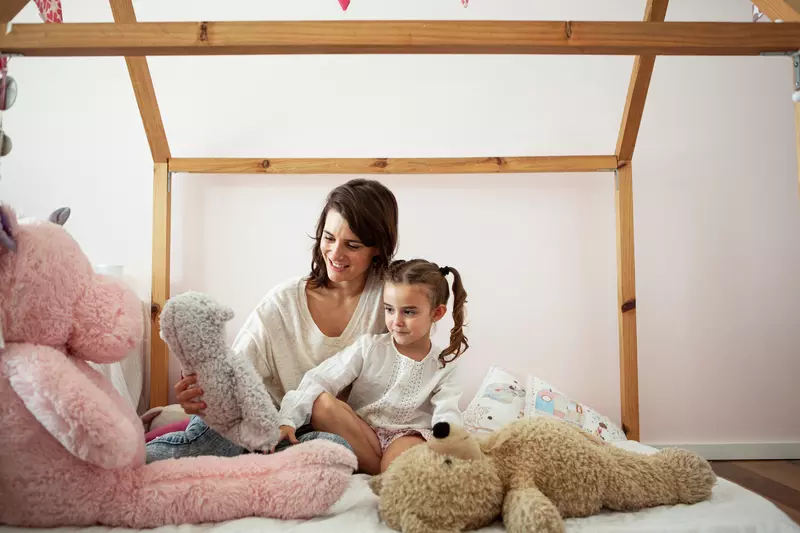- AdventHealth

Choose the health content that’s right for you, and get it delivered right in your inbox.
Montessori beds have become wildly popular. But what exactly are they? And how do you know they’re safe for your toddler? From giving some insight on what’s special about them to helping you transition your little one from the crib, our experts are here to help with details that empower you to make the best decision for your family.
What’s a Montessori Bed?
The idea of a Montessori (or floor) bed dates back to the early 1900s from a woman named Dr. Maria Montessori, who believed children thrive when they can be independent and self-reliant. And now that Montessori schools, which rely on a philosophy of a child leading their own education, have been around for decades, many parents are also starting to implement these principles into children’s home lives.
Montessori beds are essentially beds with mattresses close to the floor, without railings or other devices that might restrict a toddler’s movement. Often twin-sized, this type of bed is designed to allow toddlers to move in and out of bed independently. And for some children, that freedom can boost confidence and foster self-reliance.
Are Montessori Beds Safe?
While floor beds might be a perfect solution for some children, these beds may not be the best option for others. Montessori beds are safest for children who can manage themselves and have enough motor skills to avoid accidents. For example, if your child hasn’t quite mastered walking or tends to hurt themselves when they fall, Montessori beds might not be right for them just yet.
One concern for many parents is that because these beds don’t have railings, children might hurt themselves if they roll off. However, because these beds are low to the ground, the risk of injury is generally low if there is a carpet or rug underneath.
The dangers of Montessori beds are less about the bed itself and more about the surrounding environment. To keep your child safe, whether they sleep in a Montessori bed or not, make sure to:
- Cover electrical outlets
- Install safety gates in front of stairs
- Keep choking hazards out of reach
- Place the mattress in the middle of the room
- Secure furniture, such as dressers, to the wall
Registering the products you purchase for your child, including their bed, is also a good idea so you will receive any potential recall alerts. Or, for an updated list of recalls, visit the Consumer Product Safety Commission site.
When to Transition Your Child to a Montessori Bed
Montessori beds are not safe for babies under one year old. Depending on your child’s sleep pattern, you can consider transitioning to a toddler bed between 18 months and three years of age if they can stand up, sit down, walk and move around without hurting themselves.
As you transition your child to a Montessori bed, start with naps and see how they do. Once you feel confident, you can transition them to sleeping in their new bed at night.
How to Build or Find a Montessori Bed
If you’ve decided to try out a floor bed for your child, you have many options. The most basic bed is simply a mattress on the floor, which can be a great place to start if you’re worried about your child rolling off. When shopping for Montessori beds, look for options with low, accessible frames since they have a lower risk for injury and make it easier for your child to get in and out of bed independently. If you plan on DIY-ing your child’s Montessori bed, build from a plan that considers possible dangers for sleepy toddlers.
Choosing a Montessori Bed Mattress
Picking a mattress for a Montessori bed is essentially the same as selecting a mattress for any toddler bed. Here are a few tips:
- Consider features. For example, waterproof covers are nice to ease the cleanup of inevitable potty-training accidents. And if your child gets hot at night, a breathable mattress can help keep them cool.
- Consider materials. Toxin- and latex-free materials are the right choice for some children, especially if there’s a history of allergies.
- Consider size. Twin mattresses are great for older, growing toddlers. But a crib mattress may work in the short term until your little one grows into a larger bed. Whatever size mattress you choose, you’ll want to be sure it fits securely in its frame to prevent getting tiny fingers or toes stuck in between spaces.
Learn About Safe Sleep with AdventHealth
A good night’s sleep is good for toddlers (and everyone else in their home) — and Montessori beds might be a great place to start. Whether you’re looking for advice on transitioning your toddler to a big-kid bed or ways to help your child sleep better, speak with your pediatrician today.


